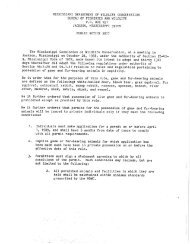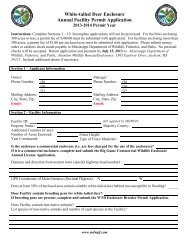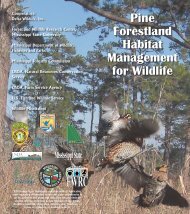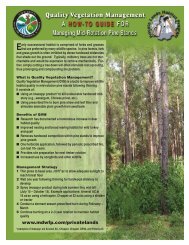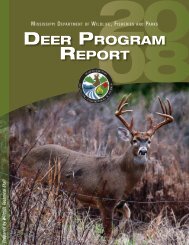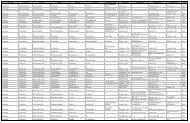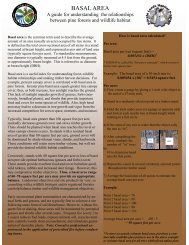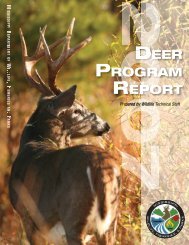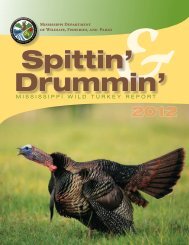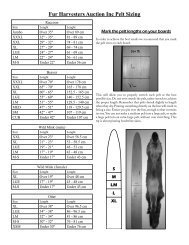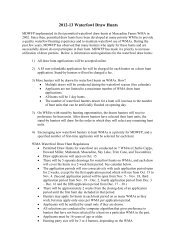Teachers Guide
Teachers Guide
Teachers Guide
You also want an ePaper? Increase the reach of your titles
YUMPU automatically turns print PDFs into web optimized ePapers that Google loves.
PlannerSchool ProgramLOCATED within lefleur’s bluff state park—LAKELAND AT I-55 • 2148 Riverside Drive JACKSON, MS • 601.576.6000 • WWW.MSNATURALSCIENCE.ORG
Look What YouCan Find Inside!Planning Your Visit 4At The Museum 6Group Activities 7Educational Programs 8-11Statewide Outreach 12Learning Resources 13Teacher Workshops 14Mark Your Calendar 15The mission of theMississippi Museum of Natural Scienceis to promote understanding and appreciationof Mississippi’s biological diversitythrough collections, research, scientific databases,education, and exhibits;and to inspire the people of our stateto respect the environmentand to preserve natural Mississippi.
Welcome!Dear Educators,We are excited about our school programming, professionaldevelopment, and upcoming events and exhibits! Utilizing ourrich resources and heritage, the Museum of Natural Science hasdesigned programming that is hands-on and inquiry based.Our programs support the 2010 Mississippi Science Frameworksand promote lifelong learning. These programs also cover avariety of topics and help children make connections with thenatural world around them.We look forward to supporting you and your students thisschool year.Sincerely,Education StaffPhoto by James Patterson“My first impression when I walked in was WOW! It’s beautiful.”- Hailey, 6 th graderMISSISSIPPI MUSEUM OF NATURAL SCIENCE • LAKELAND AT I-55 • JACKSON, MS • 601.576.6000 • WWW.MSNATURALSCIENCE.ORG3
Planning Your Visit4DIRECTIONSThe Museum is located on thegrounds of LeFleur’s Bluff StatePark in Jackson, Mississippi.Take the Lakeland Drive Eastexit off I-55, turn onto HighlandDrive, and follow the signs.HOURS OF OPERATIONMonday-Friday 8am-5pmSaturday 9am-5pmSunday 1pm-5pmThe Museum is open 356 daysa year. Visit our websitewww.msnaturalscience.orgfor holiday closings.Admission FeesWe accept the following methodsof payment: check, cash, andcredit card. We do not acceptAmerican Express.General AdmissionAdults $6.00Children 3-18 $4.00Seniors 60 and over $5.00Children under 3 FREESchool Groups10 or more students $2.00PER STUDENT<strong>Teachers</strong>/AidesBus driversChaperonesFREEWITH GROUPFREEWITH GROUPFREECAN BE A CAR OR VAN DRIVER 1 PER 10 STUDENTSADDITIONAL ADULTS REGULAR ADMISSION $6Other Educational Groups(scouts, home schools, churches, academic clubs)10 or more children $2.00PER CHILDChaperonesFREECAN BE A CAR OR VAN DRIVER 1 PER 10 CHILDRENADDITIONAL ADULTS REGULAR ADMISSION $6Adult Groups(garden clubs, church/academic GROUPS, tour buses)10 or more $5.00PER PERSONBus driversFREEWITH GROUPGIFT BAGSPre-packaged Museum gift bagsare available in $4 and $6 sizes.q If ordering, please do so atthe time of making yourreservation.q Two week advance noticeis needed for preparation ofMuseum gift bags.ChaperonesPlease help us maintain anatmosphere that is enjoyableto all.q Adult chaperones arerequired for all groups.q We require a minimum of oneadult for every 10 students.q Educators and chaperonesmust ensure that studentsstay with chaperones atall times.q Please respect Museum staff,property and other visitors.109 81211131415167Photo by James Pattersonvisit our websitemsnaturalscience.org Learn moreabout or call our facilities601-576-6000visitmsnaturalscience.orgor Call601-354-7303EXT. 105indoor exhibits(bottom floor shown only)1 White-tailed Deer (on top floor)2 Waterfowl3 Mississippi’s Extinct Species4 Stories in Stone5 Endangered Species of Mississippi6 Special Exhibit Gallery7 Earth is Our Neighborhood8 Terrestrial Habitats9 Aquatic Habitats10 Pearl River Aquarium11 Alligator Snapping Turtle12 The Swamp13 Life Up Close14 Researching & ConservingMississippi’s Wonders15 History of the Museum16 Bio Bulletin52463
Museum Facilities73,000-square foot complex~300-acre natural landscape~2.5 miles of nature trails~handicap-accessibleopen-air amphitheaterand yellow nature trail~100,000-gallonaquarium networkhousing over 200 living species~1,700-square foot greenhousecalled “The Swamp”~over 30,000-square feetof permanent exhibits~gift shop called“The Dragonfly Shoppe”~reference library~200-seat auditoriumcalled the “Rotwein Theater”~Dragonfly EnvironmentalLearning Center~Preschool “Discovery Room”ReservationSBecause of staffing and facilityrequirements, it is importantthat you make your reservationsat least two weeks in advance ofyour visit. Make a reservationby calling the Museum at601-576-6000. When makinga reservation we will need toknow the following:q School name, Contact personq Address, Phone numberq Grade level,Number of studentsq Requested date/timeq Program choicesPhoto byBarbara GaunttCONFIRMATIONSWe will mail you a reservationconfirmation, and you’ll beasked to present a copy of itat the front desk when youarrive at the Museum.q Be sure you and your grouparrive at least 10 minutesprior to your scheduledactivity session.q All programs will beginand end at their prearrangedtimes.We realize that change isinevitable and will alwaysdo our best to accommodateyour requests for alterations toconfirmations. However, spacesand time slots are limited.REMINDERSq All group members mustarrive together to receive thegroup rate.q All purchase orders shouldbe presented at the gift shopupon arrival.Photo byJames PattersonPhoto by James Patterson“My favorite part was the aquarium because of all the different types of fish!”MISSISSIPPI MUSEUM OF NATURAL SCIENCE • LAKELAND AT I-55 • JACKSON, MS • 601.576.6000 • WWW.MSNATURALSCIENCE.ORG- Reanne, 6 th grader5
At The MuseumThe welcoming facilities of the Museum are geared for groups. Take advantage of our convenientpassenger loading area, generous parking, handicap-accessible buildings and trails, coveredand open picnic spots, and a naturally inviting gift shop. To ensure a more pleasant and valuableexperience for your group, we ask everyone to follow these simple guidelines and procedures.6Photo by James PattersonFor more detailsabout ourfun-filled MuseumCall601-576-6000MUSEUM GIFT SHOPThe Dragonfly Shoppe is openfrom 9am to 4:30pm and offerspre-packaged gift bags. (SEE PAGE 4)q No more than ten studentsare allowed in the shop atone time, and they must beaccompanied by an adult.q We accept the followingmethods of payment: check,cash, and credit card. We donot accept American Express.q Please make PO’s and checkspayable to the MississippiMuseum of Natural Science.LUNCH AREASYou are welcome to eat yourlunch at the pavilion orplayground. Seating is on afirst come, first seated basis.MuseumPavilionArrival PROCEDURESq Stop at the entrance to LeFleur’s Bluff State Park.q All group members must arrive together to receive thegroup rate.q Go through the Park to the Museum. For your safety, busesare required to unload in the loading area circle in front ofthe building.q After unloading, buses should park along outer areas of theparking lot. Buses should return to the circle to reload. It is notsafe to load or unload buses along the Museum drive.q Enter the Museum and present your confirmation letter andreceipt at the front desk.q All purchase orders should be presented at the gift shopupon arrival.q You’ll be greeted by a staff member or volunteer and givenfurther instructions.Museum <strong>Guide</strong>linesFood, drinks, candy, and gum are not allowed in the Museum.~The Museum is a tobacco-free facility.~Always walk through the Museum and on the nature trails.Please don’t run.~Be courteous and walk behind rather than in frontof those who are viewing the exhibits.~It is dangerous to touch or lean against the glass cases.~Beating or tapping on the aquarium windowsdisturbs the fish and other inhabitants.~Use pencils and pens only for writing on activity sheetsprovided by your teacher or the Museum, and pleasedo not use display cases or aquariums as a writing surface.
Group ActivitiesVisiting groups can choose from a number of activities at the Museum, depending upon objectivesand time schedules. Make your reservations at least two weeks in advance and plan your arrival atleast 10 minutes before your reserved appointment. Call 601-576-6000 for more details.all agesSelf-guided Tour & Trails(1 hour Museum exhibit tour)(1.5 hours nature trails)(2.5 hours Museum exhibit & trails)(Reservations Accepted)Allow at least 1 hour tocomplete a self-guided tourof the Museum. Allow up to1.5 hours to explore our naturetrails! These trails meanderthrough wooded bluffs,river bottoms, lakes, andscenic swamplands.preschool (AGES 3 THROUGH PRE-K5)Classes (FOR SCHOOL GROUPS ONLY)Programs/Camps(Reservations Required)The Museum’s PreschoolProgram offers a variety ofopportunities for children fiveand under. Preschool childrenand their caregivers are invitedto explore the Preschool Roomduring designated hours;a staff member or volunteerwill facilitate the visit. StoryTime,“Time for Twos”(a program for children twoand under), and PreschoolSummer Camps are additionalopportunities.SCOUTS (GIRL AND CUB SCOUTS)Merit Badge Program(Reservations Required2 weeks in advance)The Museum can help yourscout group of 10 to 25 earnbadges naturally. Call and bookyour group today!Grades k-12 (SCHOOLS/HOME SCHOOLS)Hands-on Educational Programs*(30 to 45 min. each)(Reservations Required)Age-appropriate, curriculumcoordinated,hands-onpresentations for grades Kthrough 12 are available forgroups of 15 to 30 students.<strong>Teachers</strong> may choose from thesetopics: endangered species,mammals, birds, reptiles, fish,invertebrates, plants, or fossils.Wetland Program*(1 hour)(Reservations Required)The Museum offers an in-depth,hands-on wetlands program.During this experience,students learn to appreciatethe importance of wetlands bybecoming a wetlands researcherin LeFleur’s Bluff State Park bystudying the area’s soil, plants,and water. The program isavailable to groups of 10 to 25students in grades 3 through 12.Photo by James Patterson*See pages 8-11 of this plannerfor details and selections.“This was the best field trip I’ve ever been on! I wish I could stay there forever.”MISSISSIPPI MUSEUM OF NATURAL SCIENCE • LAKELAND AT I-55 • JACKSON, MS • 601.576.6000 • WWW.MSNATURALSCIENCE.ORG- Chris, 6 th grader7
8Educational ProgramsAPPROPRIATE CLASSESFOR AGES 3 THROUGH PRE-K 5(10-16 CHILDREN PER GROUP)(RESERVATIONS REQUIRED)AGE-APPROPRIATE PROGRAMSFOR GRADES K THROUGH 12(30 TO 45 MIN. EACH)(15-30 STUDENTS PER GROUP)(RESERVATIONS REQUIRED)Curriculum-coordinated, hands-on presentations for grades K through 12 are available Septemberthrough May for groups of 15 to 30 students. Pages 8-11 of this School Planner show the directcorrelations of our hands-on programs with your Mississippi Science 2010 Frameworks! <strong>Teachers</strong> maychoose from the following program topics: endangered species, mammals, birds, reptiles, fish,invertebrates, plants, or fossils. To reserve a program with your field trip call 601-576-6000.PRE-KINDERGARtENClasses* and TimesClasses for ages 3 throughPre-K 5 are available foreducational groups of 10to 16 children. Preschoolclass topics vary from yearto year and center aroundhabitat, classification, andadaptations. Check ourMuseum website for currenttopics or call ourPreschool Coordinator formore information—601-576-6000.Reserved Group AccessFall/Winter/Spring Schedule (Aug-May)MON-FRI 9:00, 9:45 & 10:30amSummer Schedule (Jun-Jul)WED & FRI 9:00, 9:45 & 10:30amTime for Twos (ages 2 and under)every second Tues. 1pm-4pmStory Time (ages 3 to 5)Fall/Winter/Spring Schedule (Aug-May)WED 1:15, 2:15, 3:15pmSummer Schedule (Jun-Jul)TUE & THU 10:15am & 11:15amClass TimesCall Preschool Coordinatorat 601-576-6000.KINDERGARtENMarvelous MammalsLearn the characteristics of a mammal.How do they feel? Soft? Scaly?Come investigate marvelous mammals.Strand: Life ScienceGrade: KMS Science Framework: 3a. 3d. 3e.Slither, Slide, Creep, and CrawlLearn the characteristics of a reptile.How do snakes feel? Smooth? Slimy?Come learn interesting factsabout Mississippi’s reptiles!Strand: Life ScienceGrade: KMS Science Framework: 3a. 3d. 3e.Birds of a FeatherLearn the characteristics of a bird.Do birds have different beaks and feet?Come learn interesting factsabout Mississippi birds!Strand: Life ScienceGrade: KMS Science Framework: 3a. 3d. 3e.1ST GRADEMarvelous MammalsLearn the characteristics of a mammal.What is a habitat? Students willinvestigate fur, tracks and even scat!Strand: Life ScienceGrade: 1MS Science Framework: 3a. 3e.Photo byJames PattersonSlither, Slide, Creep, and CrawlLearn the characteristics of a reptile.Where do reptiles live? Get allthe interesting facts about Mississippi’sreptiles!Strand: Life ScienceGrade: 1MS Science Framework: 3a. 3e.Birds of a FeatherLearn the characteristics of a bird.Why do birds have different beaksand feet? Come learn interesting factsabout Mississippi birds!Strand: Life ScienceGrade: 1MS Science Framework: 3a. 3e.2ND GRADEMarvelous MammalsLearn the characteristics of a mammal.Are all mammals carnivores? Studentswill investigate fur, skulls, tracks andeven scat!Strand: Life ScienceGrade: 2ndMS Science Framework: 3a. 3c. 3e.Slither, Slide, Creep, and CrawlLearn the characteristics of a reptile.Are they cold blooded? Get allthe interesting facts about Mississippi’sreptiles!Strand: Life ScienceGrade: 2ndMS Science Framework: 3a. 3c. 3e.Photo byJames PattersonBirds of a FeatherLearn the characteristics of a bird.Are they vertebrates? Come learninteresting facts about Mississippibirds!Strand: Life ScienceGrade: 2ndMS Science Framework: 3a. 3c. 3e.3RD GRADEDig This!Learn fascinating facts about fossils.What are they? How did they form?What was Mississippi like then?Strand: Earth & Space ScienceGrade: 3rdMS Science Framework: 4g.Marvelous MammalsLearn the characteristics of a mammal.How are mammals adapted to survive?Students will investigate fur, skulls,tracks and even scat!Strand: Life ScienceGrade: 3rdMS Science Framework: 3a. 3c. 3e.Slither, Slide, Creep, and CrawlLearn the characteristics of a reptile.Do they have good camouflage?Get all the interesting factsabout Mississippi’s reptiles!Strand: Life ScienceGrade: 3rdMS Science Framework: 3a. 3c. 3e.
*Pre-K classes are designed tocorrelate with the MississippiPre-Kindergarten CurriculumBenchmarks and Expectationsfor Scientific Investigation forThree Year Old Children, andCompetencies and Objectivesfor Scientific Investigationfor Four Year Old Children.Classes are also correlatedwith the NAEYC Standard 2:Curriculum.Some Things a Little FishyLearn the characteristics of a fish.Where do fish live?Come learn about Mississippi’s fish!Strand: Life ScienceGrade: KMS Science Framework: 3a. 3d. 3e.“We really enjoyedcoming to see theMuseum and it wasby far the BESTfield trip ever!”Reserve a K-12hands-on programfor your field trip!Call601-576-6000Some Things a Little FishyLearn the characteristics of a fish.Do all fish have the same habitat?Come learn what kind of fishare in Mississippi.Strand: Life ScienceGrade: 1MS Science Framework: 3a. 3e.2Green Power3Learn the characteristics of a plant.Be a part of building a tree! Comeinvestigate common Mississippi plants!Strand: Life ScienceGrade: 2ndMS Science Framework: 3a. 3d.Some Things a Little FishyLearn the characteristics of a fish.Are fish important? Come learnwhat kinds of fish are in Mississippi.Strand: Life ScienceGrade: 2ndMS Science Framework: 3a. 3c. 3e.Here Today, Gone TomorrowLearn which species are endangered.How did they become endangered?Come meet one of our very ownendangered species and learn whatyou can do to help preserve it.Strand: Life ScienceGrade: 2ndMS Science Framework: 3c.Boneless BunchLearn the characteristics of aninvertebrate. Compare vertebrates andinvertebrates. Come investigate thisboneless bunch!Strand: Life ScienceGrade: 2ndMS Science Framework: 3a.Birds of a FeatherLearn the characteristics of a bird.What makes birds good predators?Come learn interesting factsabout Mississippi birds!Strand: Life ScienceGrade: 3rdMS Science Framework: 3a. 3c. 3e.Photo byBill StriplingSome Things a Little FishyLearn the characteristics of a fish.Do all fish eat the same way?Come learn what kinds of fishare in Mississippi.Strand: Life ScienceGrade: 3rdMS Science Framework: 3a. 3c. 3e.Put on Your Boots!During this experience at LeFleur’sBluff State Park, students will learn theimportance of wetlands by becomingwetlands researchers in the study ofsoil, plants, and water.Strand: Life ScienceGrade: 3rdMS Science Framework: 3a. 3c. 3d. 3e.“I like the nature trail because it was peaceful there. I would like to spend a long time there.”MISSISSIPPI MUSEUM OF NATURAL SCIENCE • LAKELAND AT I-55 • JACKSON, MS • 601.576.6000 • WWW.MSNATURALSCIENCE.ORG- Hunter, 6 th grader9
AGE-APPROPRIATE PROGRAMSFOR GRADES K THROUGH 12(30 TO 45 MIN. EACH)(15-30 STUDENTS PER GROUP)(RESERVATIONS REQUIRED)Educational ProgramsCurriculum-coordinated, hands-on presentations for grades K through 12 are available Septemberthrough May for groups of 15 to 30 students. Pages 8-11 of this School Planner show the directcorrelations of our hands-on programs with your Mississippi Science 2010 Frameworks! <strong>Teachers</strong> maychoose from the following program topics: endangered species, mammals, birds, reptiles, fish,invertebrates, plants, or fossils.TO RESERVE A HANDS-ONPROGRAM FOR YOUR FIELD TRIPTO THE MUSEUM PLEASE CALL601-576-6000.104 569114TH GRADESlither, Slide, Creep, and CrawlLearn the characteristics of a reptile.What is our state reptile? Get all theinteresting facts about Mississippi’sreptiles!Strand: Life ScienceGrade: 4thMS Science Framework: 3a. 3c.Marvelous MammalsLearn the characteristics of a mammal.How do you identify an animal by itsskull? Students will investigate fur,tracks and even scat!Strand: Life ScienceGrade: 4thMS Science Framework: 3a. 3c.Photo byJames PattersonBirds of a FeatherLearn the characteristics of a bird.What structures do birds have forsurvival? Come learn interestingfacts about Mississippi birds!Strand: Life ScienceGrade: 4thMS Science Framework: 3a. 3c.5TH GRADESlither, Slide, Creep, and CrawlLearn the characteristics of a reptile.Why are they always soaking upthe sun? Get all the interestingfacts about Mississippi’s reptiles!Strand: Life ScienceGrade: 5thMS Science Framework: 3a. 3e.Marvelous MammalsLearn the characteristics of a mammal.Why is the beaver skull flat on the top?Students will investigate skulls, fur,tracks and even scat!Strand: Life ScienceGrade: 5thMS Science Framework: 3a. 3e.Birds of a FeatherLearn the characteristics of a bird.Do all birds eat seeds? Come learninteresting facts about Mississippibirds!Strand: Life ScienceGrade: 5thMS Science Framework: 3a. 3e.Some Things a Little FishyLearn the characteristics of a fish.Why are flounders flat? Come learnwhat kind of neat fish are in Mississippi.Strand: Life ScienceGrade: 5thMS Science Framework: 3a. 3e.6TH-8TH GRADEHere Today, Gone TomorrowLearn which species are endangered.How did they become endangered?Come meet one of our very ownendangered species and learn what youcan do to help preserve it.Strand: Life ScienceGrade: 6thMS Science Framework: 3e.Peregrine FalconPut on Your Boots!During this experience at LeFleur’sBluff State Park, students will learn toappreciate the importance of wetlandsby becoming wetlands researchers inthe study of soil, diversity of plants,and aquatic invertebrates.Strand: Life ScienceGrade: 6thMS Science Framework: 3e.9TH-12TH GRADEPut on Your Boots!During this experience at LeFleur’sBluff State Park, students will learn toappreciate the importance of wetlandsby becoming wetlands researchers inthe study of water, soil, plants, andaquatic invertebrates. Students willcollect and investigate invertebratesas indicators of pollution in thewetland environment.Strand: Life ScienceGrade: Biology IMS Science Framework: 3b. 3c.Here Today, Gone TomorrowLearn which species are endangered.How did they become endangered?What can you do for theendangered species in Mississippi?Strand: Life ScienceGrades: Biology IMS Science Framework: 3b. 3c.Dig This!Learn facts about fossils. What arethey? How did they form? What wasMississippi like then? Come learn thegeologic timetable of Earth’s history.Strand: Life ScienceGrade: Biology IIMS Science Framework: 4a. 4d. 5a.Put on Your Boots!During this experience at LeFleur’sBluff State Park, students will becomewetlands researchers in the studyof water, soil, plants, and aquaticinvertebrates. Students will collect andinvestigate invertebrates as indicatorsof pollution in the wetland environment.Students will understand that wetlandsare important to all living organisms!Strand: Earth & Space ScienceGrade: Marine & Aquatic ScienceMS Science Framework: 2a.Here Today, Gone TomorrowLearn which species are endangered.How did they become endangered?How do humans impact theenvironment? How can you getinvolved in conservation effortsto help these endangered species?Strand: Earth & Space ScienceGrade: Environmental ScienceMS Science Framework: 3a.American Burying BeetlePhoto by Susan Middleton &David Liittschwager
Some Things a Little FishyLearn the characteristics of a fish.Why do some fish feed only onthe bottom? Come learn interestingfacts about Mississippi’s fish!Strand: Life ScienceGrade: 4thMS Science Framework: 3a. 3c.Here Today, Gone TomorrowLearn which species are endangered.What is extinction? Come meet oneof our very own endangered speciesand learn what you can do to helppreserve it.Strand: Life ScienceGrade: 4thMS Science Framework: 3a. 3c.Dig This!Learn fascinating facts about fossils.How did they form?How have things changed?What was Mississippi like then?Strand: Life ScienceGrade: 4thMS Science Framework: 3a.Put on Your Boots!During this experience at LeFleur’sBluff State Park, students will learn toappreciate the importance of wetlandsby becoming wetlands researchers inthe study of soil, plants, and water.Strand: Life ScienceGrade: 4thMS Science Framework: 3a. 3c. 3e.Here Today, Gone TomorrowLearn which species are endangered.How did they become endangered?Come meet one of our very ownendangered species and learn what youcan do to help preserve it.Strand: Life ScienceGrade: 5thMS Science Framework: 3a. 3e.Put on Your Boots!During this experience at LeFleur’sBluff State Park, students will learn toappreciate the importance of wetlandsby becoming wetlands researchers inthe study of soil, diversity of plants,and aquatic invertebrates.Strand: Life ScienceGrade: 5thMS Science Framework: 3a. 3e.Dig This!Learn fascinating facts about fossils.How did they form? How has life andthe environment changed since then?Strand: Life ScienceGrade: 5thMS Science Framework: 3a.Photo byJames Patterson7 10endangered species and learn what youHere Today, Gone TomorrowLearn which species are endangered.How did they become endangered?Come meet one of our very owncan do to help preserve it.Strand: Life ScienceGrades: 7th & 8thMS Science Framework: 3a.Put on Your Boots!During this experience at LeFleur’sBluff State Park, students will learn to8appreciate the importance of wetlandsby becoming wetlands researchers inthe study of soil, diversity of plants,and aquatic invertebrates.Strand: Life ScienceGrade: 7th & 8thMS Science Framework: 3a.Boneless BunchLearn the characteristics of aninvertebrate. How do you classifydifferent invertebrates?Come investigate this boneless bunch!Strand: Life ScienceGrade: Biology IIMS Science Framework: 5b.Green PowerHow do you identify plants?What is a native plant?Come investigate commonMississippi plants!Strand: Life ScienceGrade: BotanyMS Science Framework: 2d.“I have learned a lotin the Museum.I really want tocome back one dayand learn MORE.”Put on Your Boots!During this experience at LeFleur’sBluff State Park, students will becomewetlands researchers in the studyof water, soil, plants, and aquaticinvertebrates. Students will collect andinvestigate invertebrates as indicatorsof pollution in the wetland environment.Students will understand that wetlandsare important to all living organisms!Strand: Earth & Space ScienceGrade: Environmental ScienceMS Science Framework: 3a.Dig This!Learn facts about fossils. How did theyform? What is a geological timescale?What are some major geological12features in Mississippi?What was Mississippi like then?Strand: Earth & Space ScienceGrade: GeologyMS Science Framework: 2g. 2j.“It was wonderful! I only wish my classroom had so many fun things!”MISSISSIPPI MUSEUM OF NATURAL SCIENCE • LAKELAND AT I-55 • JACKSON, MS • 601.576.6000 • WWW.MSNATURALSCIENCE.ORG- Mississippi Teacher11
Teacher WorkshopsMuseum staff provide training in internationally recognized environmental education programs forteachers. These programs can be conducted for teachers of all subjects and grade levels either inyour school or at the Museum. These workshops are excellent for informal educators such as scoutleaders, camp leaders, and youth leaders of any kind!14For moreteacheropportunitiesCall601-576-6000Project WILDWildlife in Learning DesignProject WILD capitalizes onthe natural interest thatchildren and adults have inwildlife by providing hands-onactivities that enhance studentlearning in all subject and skillareas K-12.Project WILD AquaticProject WILD Aquatic isa conservation educationprogram focused on aquaticwildlife and ecosystems for K-12educators and their students.WOW!the wonders of wetlandsWOW! The Wonders ofWetlands is a valuable resourcefor teachers, which buildsrespect and environmentalappreciation among studentsthrough participation inengaging wetland activities.This workshop is for teachersthat work with grades K-12.Project WetWater Education For <strong>Teachers</strong>Project WET, for kindergartenthrough 12th grade educators,is a collection of innovative,water-related activities thatare hands-on, easy to use, andfun! Project WET activitiesincorporate a variety of formats,such as large and small grouplearning, whole-body activities,laboratory investigations,discussion of local and globaltopics, and involvement incommunity service projects.Flying WILDFlying WILD introducesstudents to bird conservationthrough standards-basedclassroom activities andenvironmental stewardshipprojects. Flying WILDencourages schools to workclosely with conservationorganizations, communitygroups, and businesses involvedwith birds to implementschool bird festivals and birdconservation projects.This workshop is for teachersthat work with grades K-12.growing up WILDGrowing Up WILD featuresnew activities designed tostimulate young children innew and exciting ways whileconnecting them to natureand many of its wonders.Growing Up WILD is a nationalearly childhood initiativethat builds literacy skills andenvironmental appreciationamong early learners throughparticipation in engagingwildlife-based educationalactivities. This workshopis suggested for teachers thatwork with ages 3-7.WOW!TheWondersofWetlandsAquatic“I didn’t know those beautiful fish could get that big!”- Gabby, 5 th grader
MMNS:08:11MISSISSIPPI MUSEUM OF NATURAL SCIENCE2148 Riverside DriveJACKSON, MS 39202-1353PlannerSchool ProgramLook what you can find inside!Planning Your Visit 4At The Museum 6Group Activities 7Educational Programs 8-11Statewide Outreach 12Learning Resources 13Teacher Workshops 14Mark Your Calendar 15Non-Profit Org.U.S. PostagePAIDJackson, Miss.permit no. 932



